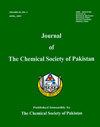用1D [Pr(BTC)(H2O)6] MOF作为填料制备Matrimidand#174基于嗯
IF 0.5
4区 化学
Q4 CHEMISTRY, MULTIDISCIPLINARY
Journal of the chemical society of pakistan
Pub Date : 2023-01-01
DOI:10.52568/001245/jcsp/45.03.2023
引用次数: 0
摘要
选择良好的填料-聚合物对可以提高气体分离性能。本研究通过三种重量(10、20和30重量%)的1D棒状纳米多孔[Pr(BTC)(H2O)6]金属有机骨架(MOF)来制备基于基质的杂化或混合基质膜(MMMs)。傅里叶变换红外(FTIR)分光光度分析表明,镧系金属离子与连接剂结合形成了MOF,并进一步揭示了MOF进入聚合物基体后结构保持完整。粉末x射线(PXRD)分析显示了MOF的纯度和结晶度,而MMMs的PXRD结果表明MMMs制备后MOF的结晶度没有受到影响。扫描电子显微镜(SEM)结果表明MOF的形成与先前报道的形态相同。此外,观察到添加剂颗粒在整个聚合物基体中的均匀分布和良好的粘附性,而界面空隙明显不存在。MOF和MMMs均表现出热稳定性,分散到聚合物基体后,MOF颗粒的结晶度保持不变。得到了MOF的布鲁诺尔-埃米特-泰勒(BET)表面积,表明其具有永久孔隙率。所制备的mm具有足够的灵活性来处理所有的分析。这些发现导致得出结论,适当的聚合物-填料对,生产无缺陷的mm。在改性填料的孔隙后,可以评价所制备的MMMs在分离不同气体方面的性能本文章由计算机程序翻译,如有差异,请以英文原文为准。
Use of 1D [Pr(BTC)(H2O)6] MOF as a Filler for Fabrication of Matrimidand#174; based MMMs
Selection of good filler-polymer pair results in improved gas separation performances. Present study deals with fabrication of Matrimid based hybrid or mixed matrix membranes (MMMs) by using three weight loadings (10, 20 and 30 wt. %) of 1D rod shaped nanoporous [Pr(BTC)(H2O)6] metal organic framework (MOF). The fourier transform infrared (FTIR) spectrophotometric analysis indicated the bonding of lanthanide metal ion with the linker and thus formation of the MOF, and further revealed that the structure of MOF remained intact after incorporation into the polymer matrix. Powder X-ray (PXRD) analysis revealed purity and crystallinity of the MOF while the PXRD results for the MMMs indicated that crystallinity of the MOF remained unaffected after fabrication of the MMMs. The Scanning electron microscopy (SEM) results gave an indication of the formation of the MOF in same morphology as it is previously reported. Additionally, nice distribution and well adherence of the additive particles throughout the polymer matrix was observed while the interfacial voids were visibly absent. The MOF and the MMMs were thermally stable and crystallinity of MOF particles remained intact after dispersion into polymer matrix. The Brunauer Emmett Teller (BET) surface area of the MOF was also obtained that indicated its permanent porosity. The prepared MMMs were flexible enough to handle for all analysis. These findings led to conclude that a proper polymer-filler pair was made that produced defect free MMMs. The prepared MMMs can be evaluated in future for their performance towards separation of different gases after modification of the pore of the filler
求助全文
通过发布文献求助,成功后即可免费获取论文全文。
去求助
来源期刊
CiteScore
1.30
自引率
14.30%
发文量
41
审稿时长
3.4 months
期刊介绍:
This journal covers different research areas in the field of Chemistry. These include; Analytical Chemistry, Applied Chemistry, Biochemistry, Environmental Chemistry, Industrial Chemistry, Inorganic Chemistry, Organic Chemistry and Physical Chemistry. The journal publishes full length articles and Reviews from researchers in academia in addition to featuring comments. Chemical Research presents short, concise and critical articles offering easy-to-read overviews of basic research and applications in all areas of chemistry.

 求助内容:
求助内容: 应助结果提醒方式:
应助结果提醒方式:


